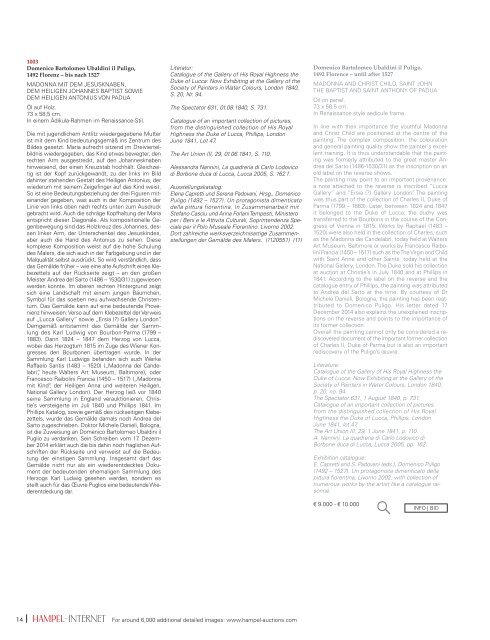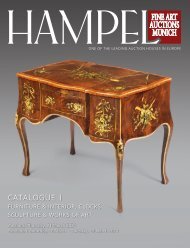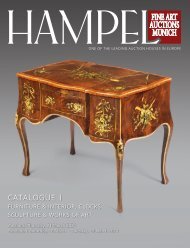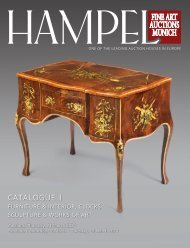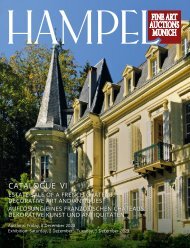Erfolgreiche ePaper selbst erstellen
Machen Sie aus Ihren PDF Publikationen ein blätterbares Flipbook mit unserer einzigartigen Google optimierten e-Paper Software.
1003<br />
Domenico Bartolomeo Ubaldini il Puligo,<br />
1492 Florenz – bis nach 1527<br />
MADONNA MIT DEM JESUSKNABEN,<br />
DEM HEILIGEN JOHANNES BAPTIST SOWIE<br />
DEM HEILIGEN ANTONIUS VON PADUA<br />
Öl auf Holz.<br />
73 x 58,5 cm.<br />
In einem Ädikula-Rahmen im Renaissance-Stil.<br />
Die mit jugendlichem Antlitz wiedergegebene Mutter<br />
ist mit dem Kind bedeutungsgemäß ins Zentrum des<br />
Bildes gesetzt. Maria aufrecht sitzend im Dreiviertelbildnis<br />
wiedergegeben, das Kind etwas bewegter, den<br />
rechten Arm ausgestreckt, auf den Johannesknaben<br />
hinweisend, der einen Kreuzstab hochhält. Gleichzeitig<br />
ist der Kopf zurückgewandt, zu der links im Bild<br />
dahinter stehenden Gestalt des Heiligen Antonius, der<br />
wiederum mit seinem Zeigefinger auf das Kind weist.<br />
So ist eine Bedeutungsbeziehung der drei Figuren miteinander<br />
gegeben, was auch in der Komposition der<br />
Linie von links oben nach rechts unten zum Ausdruck<br />
gebracht wird. Auch die schräge Kopfhaltung der Maria<br />
entspricht dieser Diagonale. Als kompositionelle Gegenbewegung<br />
sind das Holzkreuz des Johannes, dessen<br />
linker Arm, der Unterschenkel des Jesuskindes,<br />
aber auch die Hand des Antonius zu sehen. Diese<br />
komplexe Komposition weist auf die hohe Schulung<br />
des Malers, die sich auch in der Farbgebung und in der<br />
Malqualität selbst ausdrückt. So wird verständlich, dass<br />
das Gemälde früher – wie eine alte Aufschrift eines Klebezettels<br />
auf der Rückseite zeigt – an den großen<br />
Meister Andrea del Sarto (1486 – 1530/31) zugewiesen<br />
werden konnte. Im oberen rechten Hinter grund zeigt<br />
sich eine Landschaft mit einem jungen Bäumchen,<br />
Symbol für das soeben neu aufwachsende Christentum.<br />
Das Gemälde kann auf eine bedeutende Provenienz<br />
hinweisen: Verso auf dem Klebezettel der Verweis<br />
auf „Lucca Gallery“ sowie „Ersia (?) Gallery London“.<br />
Dem gemäß entstammt das Gemälde der Sammlung<br />
des Karl Ludwig von Bourbon-Parma (1799 –<br />
1883). Dann 1824 – 1847 dem Herzog von Lucca,<br />
wobei das Herzogtum 1815 im Zuge des Wiener Kongresses<br />
den Bourbonen übertragen wurde. In der<br />
Samm lung Karl Ludwigs befanden sich auch Werke<br />
Raffaelo Santis (1483 – 1520) („Madonna dei Candelabri“,<br />
heute Walters Art Museum, Baltimore), oder<br />
Francesco Raibolini Francia (1450 – 1517) („Madonna<br />
mit Kind“, der Heiligen Anna und weiteren Heiligen,<br />
National Gallery London). Der Herzog ließ vor 1840<br />
seine Sammlung in England ver auktionieren, Christie’s<br />
versteigerte im Juli 1840 und Phillips 1841. Im<br />
Phillips Katalog, sowie gemäß des rückseitigen Klebezettels,<br />
wurde das Gemälde damals noch Andrea del<br />
Sarto zugeschrieben. Doktor Michele Danieli, Bologna,<br />
ist die Zuweisung an Domenico Bartolomeo Ubaldini il<br />
Puglio zu verdanken. Sein Schreiben vom 17. Dezember<br />
2014 erklärt auch die bis dahin noch fraglichen Aufschriften<br />
der Rückseite und verweist auf die Bedeutung<br />
der einstigen Sammlung. Insgesamt darf das<br />
Gemälde nicht nur als ein wieder entdecktes Dokument<br />
der bedeutenden ehemaligen Sammlung des<br />
Herzogs Karl Ludwig gesehen werden, sondern es<br />
stellt auch für das Œuvre Puglios eine bedeutende Wiederentdeckung<br />
dar.<br />
Literatur:<br />
Catalogue of the Gallery of His Royal Highness the<br />
Duke of Lucca: Now Exhibiting at the Gallery of the<br />
Society of Painters in Water Colours, London 1840,<br />
S. 20, Nr. 94.<br />
The Spectator 631, 01.08.1840, S. 731.<br />
Catalogue of an important collection of pictures,<br />
from the distinguished collection of His Royal<br />
Highness the Duke of Lucca, Phillips, London<br />
June 1841, Lot 47.<br />
The Art Union III, 29, 01.06.1841, S. 110.<br />
Alessandra Nannini, La quadreria di Carlo Lodovico<br />
di Borbone duca di Lucca, Lucca 2005, S. 162 f.<br />
Ausstellungskatalog:<br />
Elena Capretti und Serena Padovani, Hrsg., Domenico<br />
Puligo (1492 – 1527). Un protagonista dimenticato<br />
della pittura fiorentina. In Zusammenarbeit mit<br />
Stefano Casciu und Anna Forlani Tempesti, Ministero<br />
per i Beni e le Attivita Culturali, Soprintendenza Speciale<br />
per il Polo Museale Fiorentino. Livorno 2002.<br />
Dort zahlreiche werksverzeichnisartige Zusammenstellungen<br />
der Gemälde des Malers. (1120551) (11)<br />
Domenico Bartolomeo Ubaldini il Puligo,<br />
1492 Florence – until after 1527<br />
MADONNA AND CHRIST CHILD, SAINT JOHN<br />
THE BAPTIST AND SAINT ANTHONY OF PADUA<br />
Oil on panel.<br />
73 x 58.5 cm.<br />
In Renaissance style aedicule frame.<br />
In line with their importance the youthful Madonna<br />
and Christ Child are positioned at the centre of the<br />
painting. The complex composition, the colouration<br />
and general painting quality show the painter's excellent<br />
training. It is thus understandable that the painting<br />
was formerly attributed to the great master Andrea<br />
del Sarto (1486-1530/31) as the inscription on an<br />
old label on the reverse shows.<br />
The painting may point to an important provenance:<br />
a note attached to the reverse is inscribed “Lucca<br />
Gallery” and “Ersia (?) Gallery London”. The painting<br />
was thus part of the collection of Charles II, Duke of<br />
Parma (1799 – 1883). Later, between 1824 and 1847<br />
it belonged to the Duke of Lucca; the duchy was<br />
transferred to the Bourbons in the course of the Congress<br />
of Vienna in 1815. Works by Raphael (1483 –<br />
1520) were also held in the collection of Charles, such<br />
as the Madonna dei Candelabri, today held at Walters<br />
Art Museum, Baltimore or works by Francesco Raibolini<br />
Francia (1450 – 1517) such as the The Virgin and Child<br />
with Saint Anne and other Saints, today held at the<br />
National Gallery, London. The Duke sold his collection<br />
at auction at Christie’s in July 1840 and at Phillips in<br />
1841. According to the label on the reverse and the<br />
catalogue entry of Phillips, the painting was attributed<br />
to Andrea del Sarto at the time. By courtesy of Dr<br />
Michele Danieli, Bologna, the painting has been reattributed<br />
to Domenico Puligo. His letter dated 17<br />
December 2014 also explains the unexplained inscriptions<br />
on the reverse and points to the importance of<br />
its former collection.<br />
Overall the painting cannot only be considered a rediscovered<br />
document of the important former collec tion<br />
of Charles II, Duke of Parma but is also an important<br />
rediscovery of the Puligo’s œuvre.<br />
Literature:<br />
Catalogue of the Gallery of His Royal Highness the<br />
Duke of Lucca: Now Exhibiting at the Gallery of the<br />
Society of Painters in Water Colours, London 1840,<br />
p. 20, no. 94.<br />
The Spectator 631, 1 August 1840, p. 731.<br />
Catalogue of an important collection of pictures,<br />
from the distinguished collection of His Royal<br />
Highness the Duke of Lucca, Phillips, London<br />
June 1841, lot 47.<br />
The Art Union III, 29, 1 June 1841, p. 110.<br />
A. Nannini, La quadreria di Carlo Lodovico di<br />
Borbone duca di Lucca, Lucca 2005, pp. 162.<br />
Exhibition catalogue:<br />
E. Capretti and S. Padovani (eds.), Domenico Puligo<br />
(1492 – 1527). Un protagonista dimenticato della<br />
pittura fiorentina, Livorno 2002, with collection of<br />
numerous works by the artist like a catalogue raisonné.<br />
€ 9.000 - € 10.000<br />
Sistrix<br />
INFO | BID<br />
tions.com<br />
14 For around 6,000 additional detailed images: www.hampel-auctions.com


